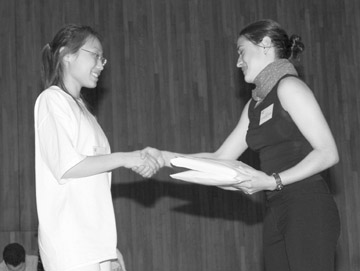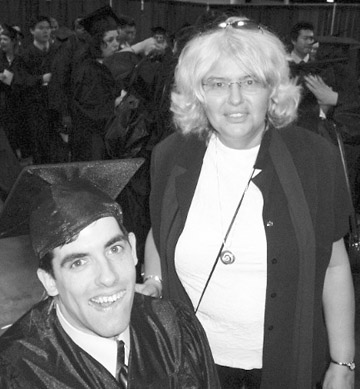’05 Budget “Blissfully Boring”
May 6, 2004
Next year’s budget is “blissfully boring,” showing no steep drops or massive reallocations, in contrast to the staggering budget cuts of $30 million since 2001, according to UMass Boston’s top financial official, Ellen O’Connor.
The university feels comforted by the recommendations for next year’s budget by the House of Representatives Ways and Means committee, which appropriated $331 million to UMass, with an additional $53 million for collective bargaining.
While the $331 million was a two percent cut in comparison to the $337 million in 2004’s final House budget, the collective bargaining turned it into a six percent increase, something university officials pointed to as a positive development. The House later added three million back to UMass, in effect halving the two percent cut.
“The real issue is that they’ve put in a $53 million increase to annualize the cost of the union contracts,” said University Vice President and Treasurer Stephen Lenhardt. “So that’s why it’s such a positive budget for us.”
“There’s a collective bargaining agreement omission that is modest in the amount of dollars, but huge in terms of the affected number of employees at UMass Boston, that we are working very diligently with [SEIU Local 888 and local legislators] to get included in the budget,” said O’Connor, UMass Boston’s Vice Chancellor of Administration and Finance.
Chancellor Jo Ann Gora herself lobbied for collective bargaining and an in-state tuition amendment at Beacon Hill budget sessions last Wednesday, April 28. The amendment, which would allow immigrant students to pay in-state tuition rates, failed, and the fate of collective bargaining money does not look good.
As of press time, the House did not provide the money, instead inserting a clause in the budget asking the Romney administration’s secretary of finance to submit a report to Ways and Means in July on why the money could not be given to Local 888.
Of harsh budget cuts the university has faced over the last three years, O’Connor said, “It’s so hard with little notice to have the bottom drop out of your funding.”
In response, the university went through the traditional motions as outlined in the Committee on University Revenue and Expenses (CURE) report: spending some of the savings account, reducing spending, and raising fees and revenues.
“I think that this year we expect that kind of work won’t be necessary, and that the years of substantial reductions in the amount the Commonwealth contributes will have plateau-ed,” said O’Connor, who joined the administration in January, coming from Brown University and moving from private to public higher education.
O’Connor, a former state budget director, hesitated at forecasting future events and budgets. “You work hard to the desired outcome, and get ready to deal with whatever happens,” she said.
Debate Brews Over ‘Formula’
While focus remains on the coming budget for next year, a debate brews over the distribution of new revenue to the five campuses, especially with the projection of increased funds over the next several years, as university system eyes an old formula.
Then-interim (and now permanent) President Jack Wilson had used a formula to distribute $10 million that was included in a January supplemental budget.
“The formula itself had been kicking around for a number of years, ten years, and its original purpose, we are told, is that it was being developed to make the argument for what the appropriation to the university system ought to be,” O’Connor said, “but [it] morphed into being the allocation once the appropriation was made.”
Formulas are in practice in a number of states for public higher education. The university has been working closely with the President’s Office, and Chancellor Gora has been told that the formula will be used for new funds and not the base budget.
During a recent Faculty Council meeting, O’Connor pointed out that under the formula, UMass Dartmouth actually ends up owing the state money.
“It’s always a challenge to create a formula that reflects reality and I think we still have some work to do on the formula, because I don’t think it reflects reality yet,” she said.
One of the flaws in the formula is its definition of a teaching assistant, said O’Connor. The formula assigns the title of T.A. to a graduate student teaching a class. At UMass Boston, a T.A. can be someone who teaches a class, or grades papers for faculty, or does research for the curriculum.
“Essentially, the way the formula worked, it assigned us more T.A.’s than we could ever possibly use, and fewer faculty,” said Neil Rosenburg, assistant vice chancellor of administration and finance.
Another flaw is it “rewards history.” “In other words, if you used to spend a lot, it rewards you and gives you more money. If you didn’t used to spend a lot, then it harms you,” O’Connor said. “Well, that’s baloney.”
Lenhardt says the formula is indeed based on historical amounts, with some minor tweaking for enrollment levels. While noting O’Connor’s concerns, “we don’t necessarily share those concerns,” he said. “But rule #1 is we never take away money from a campus. That’s our first rule. So if your base is X, we may give you slightly less than the next year, but we never take away.”
O’Connor said that the university is actively taking an internal look at what can be done with the new formula.
“We are involved with the faculty, to really take a look at how we score, and why we score the way we score and, you know, are we satisfied with the way we’re treated in the formula,” she said. “You can anticipate that we feel that we’re not fairly treated in the formula and are working on anything we can change inside ourselves that we agree with that we want to change.”























































